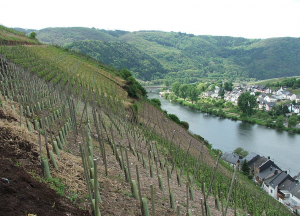Along with Chardonnay and Sauvignon Blanc, Riesling is considered one of the world's greatest white wines. Riesling has a long history, even for a wine: it has been produced for at least 600 years. Rieslings are highly versatile: they cover a wide range from dry, crisp wine perfect for a spring picnic, to highly sweet dessert wines with complex, unctuous flavors.
range from dry, crisp wine perfect for a spring picnic, to highly sweet dessert wines with complex, unctuous flavors.
Riesling grapes originated in the Rhine region of Germany. They are highly aromatic, imparting flowery, perfumed scents and high acidity to the wines they produce. Riesling grapes are known for their expression of terroir, or the unique qualities of the soil they are grown in. In addition, Riesling wines are hardly ever aged in oak barrels, meaning that their flavor and aroma is not changed by the addition of flavor compounds from the wood. As a result, Riesling is prized for its clean, pure reflection of the soil in which its grapes are grown.
Riesling grapes need a rare environment: cool, with lots of sun and protection from the wind. Small microclimates that fulfill these conditions often produce the best Rieslings. Vineyards in Germany along the Mosel River and the French region of Alsace produce what are arguably the world's best Rieslings. Other notable areas are: Washington, Oregon, and in California, Santa Barbara, Monterey, Santa Cruz, and Mendocino. Australia, South Africa, Austria, Chile, Switzerland, Russia, Yugoslavia, and Italy also grow Riesling grapes, but their product is generally of lesser quality.
Riesling grapes are fairly hardy in that they withstand cold well, but one rainy day can ruin a whole crop. Riesling grapes left on the vine in wet weather develop the Botrytis cinerea fungus, more commonly known as Noble Rot. The name "Noble Rot," is truly a contradiction in terms, for this fungus is actually welcome by viticulturists. In the late 18th century in Johannisberg, a vineyard's workers received permission to harvest too late. The grapes began to rot before they were picked, but the resulting beverage was remarkably tasty. Noble rot causes the grapes to shrivel and the juices to evaporate, resulting in a wine with a sweeter, more concentrated and dynamic flavor. This is particularly suited to Riesling grapes, which have the acidity needed to balance out the added sweetness, and in fact, Noble Rot helps to produce many great Riesling dessert wines.
Riesling's flavor profile is highly fruity, balancing its high acidity with flavors of apple, pear or apricot, and floral aromas of rose and violet. Because its taste so faithfully reflects its soil of origin, Rieslings can also have natural mineral tastes like flint, steel, and gunmetal. Aged Rieslings can develop a distinct petroleum taste, but because it develops in grapes grown in ideal conditions and is thus present in often-great wines, these petroleum notes are actually prized by wine connoisseurs.
Riesling pairs well with many food. Try the lighter, crisper Rieslings with delicate dishes like poached fish or simple salads. The sweeter, more full-bodied and minerally Rieslings pair exceptionally well with foods with strong spices and sauces, especially Asian foods.
Celebrate the beginning of spring by trying a Riesling tonight!


